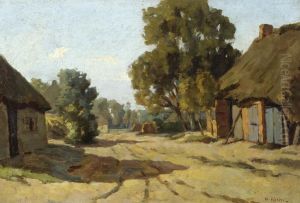Willem Hendrik Kohler Paintings
Willem Hendrik Koller, often also spelled as Kohler, was a Dutch painter, born on August 10, 1875, in Amsterdam, the Netherlands. He is best known for his role in the Dutch impressionist movement, sometimes referred to as the Hague School, although his style also embraced aspects of Realism. Koller's early life was steeped in the rich artistic heritage of the Netherlands, a country renowned for its contributions to the visual arts, particularly during the Dutch Golden Age of painting.
Koller's artistic journey began at a young age under the influence of his environment and the artistic legacy of his homeland. He was trained at the Rijksakademie van beeldende kunsten (State Academy of Fine Arts) in Amsterdam, where he was exposed to the teachings of prominent Dutch artists of the time. This period of study was crucial in shaping his technical skills and artistic sensibilities.
During his career, Koller developed a distinctive style characterized by a deft handling of light and shadow, as well as a keen interest in capturing the everyday lives of his subjects. His works often depicted scenes of rural and urban life, landscapes, and seascapes, reflecting a fascination with the interplay between humans and their surroundings. Koller's paintings resonated with the tones and moods of the Dutch landscape, encapsulating the unique light and atmosphere of the lowlands.
Despite the relative obscurity of Willem Hendrik Koller in comparison to some of his contemporaries, his contributions to the Dutch art scene were significant. He was part of the artistic milieu that continued to innovate and expand upon the rich traditions of Dutch painting. His works were exhibited in various galleries, contributing to the cultural tapestry of the Netherlands.
Willem Hendrik Koller passed away on January 28, 1941, in Blaricum, Netherlands. His legacy is preserved through his artworks, which continue to be appreciated by art historians and collectors. Koller's paintings remain as a testament to the enduring qualities of Dutch impressionism and its ability to capture the subtle nuances of light and life.
